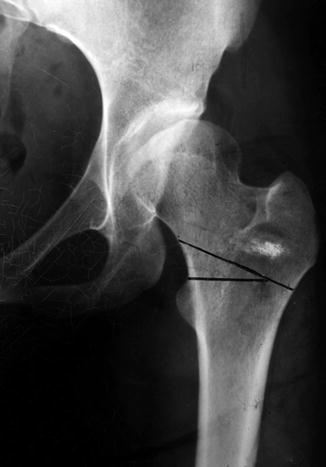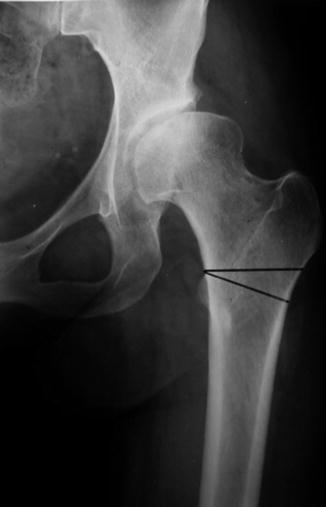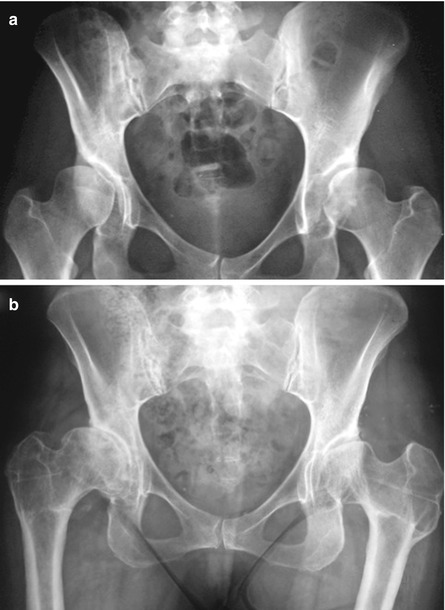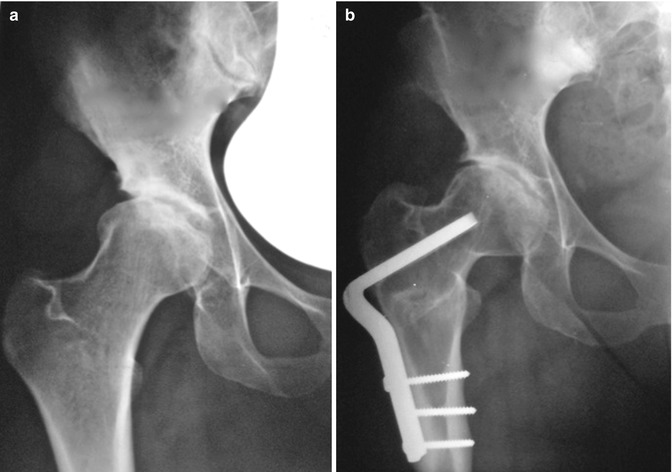, George C. Babis2 and Kalliopi Lampropoulou-Adamidou3
(1)
Orthopaedic Department Medical School, National and Kapodistrian University, Athens, Greece
(2)
2nd Orthopaedic Department Medical School, National and Kapodistrian University Nea Ionia General Hospital “Konstantopoulion”, Athens, Greece
(3)
3rd Orthopaedic Department, National and Kapodistrian University KAT General Hospital, Athens, Greece
Abstract
Patients with early stages of osteoarthritis of the hip are treated conservatively: education, physiotherapy, weight reduction, simple analgesics and occasionally nonsteroidal anti-inflammatory drugs.
Intertrochanteric and pelvic osteotomies have limited indications, and as surgeons’ experience is also limited, in our days, this type of surgery is seldom performed.
5.1 Conservative Management
Treatment of secondary osteoarthritis (OA) due to congenital hip disease (CHD) in adults is surgical, when pain and disability of the patients significantly alter their quality of life. Before this stage, non-pharmacological conservative treatment includes education, physiotherapy , weight reduction and avoidance of extreme activities, including sports, except swimming. In older patients, the use of a cane may postpone, for a few years, the need for surgery.
Pharmacological treatment options may include:
Simple analgesics like paracetamol
Symptomatic slow-acting drugs in OA (SYSADOA) like hyaluronanic acid, chondroitin sulphate, glucosamine sulphate and diacereine. Their therapeutic role in terms of pain relief and slowing the progression of OA is debated [1].
Nonsteroidal anti-inflammatory drugs (NSAIDs) . Although they are acting immediately to inflammation, which is the main cause of pain in the initial stages of OA, these drugs are associated with serious adverse events particularly from the gastrointestinal system. The development of selective cyclo-oxygenase-2 (COX-2) inhibitors reduces the incidence of upper gastrointestinal tract ulcerations; however, other toxicities such as hypertension, cardiovascular events and thromboembolic complications still remain a considerable risk [2, 3].
Intra-articular corticosteroids are also used, particularly when there is moderate to severe pain not responding to the above-mentioned oral medications. However, repeated injections are considered harmful for the joint cartilage and are not recommended [4].
To date we can only treat symptoms in mild to moderate cases but we cannot modify the course of the disease. The management of OA is limited to control pain and inflammation. The aim of recent pharmacological studies is the development of conservative treatment of OA with chondroprotective or chondrotherapeutic agents.
5.2 Osteotomies
The treatment of choice in patients with dysplastic hips before the advent of total hip replacement (THR) was intertrochanteric and pelvic osteotomies [5–14]. Pauwels’ main concept, expanded by Bombelli, was that the reduction of excessive joint pressure, in dysplastic hips, may prevent the development of OA.
Osteotomies were the only surgical solution, at these early years, and as they were performed without clear indications, their results were not always successful. Best results were obtained, with the varus intertrochanteric osteotomy , in the dysplastic hips at the early stage of the degenerative changes and with the valgus osteotomy at a later stage (Figs. 5.1 and 5.2). The senior author of this book (GH) used these types of osteotomies, during the 1960s and 1970s with good results (Figs. 5.3, 5.4 and 5.5).




Fig. 5.1
Varus osteotomy performed by removal of a bony wedge with a medial base

Fig. 5.2
Valgus osteotomy performed by removal of a bony wedge with a lateral base

Fig. 5.3
Twenty-eight-year-old female with bilateral dysplastic hips. She had mild pain for 2 years of the right hip. In 1983, we performed a varus intertrochanteric osteotomy in both hips within 20 days. (a) Preoperative radiograph. (b) Thirty years after osteotomies. Patient, at the age of 58, is free of symptoms










